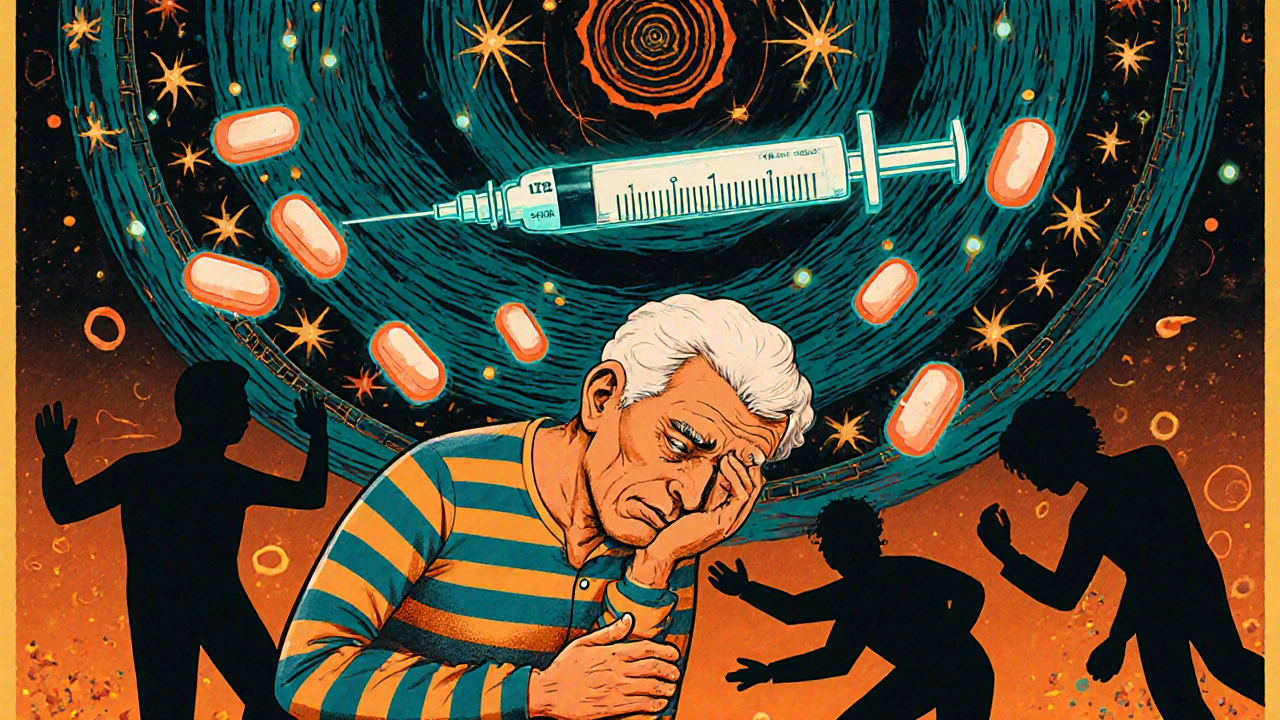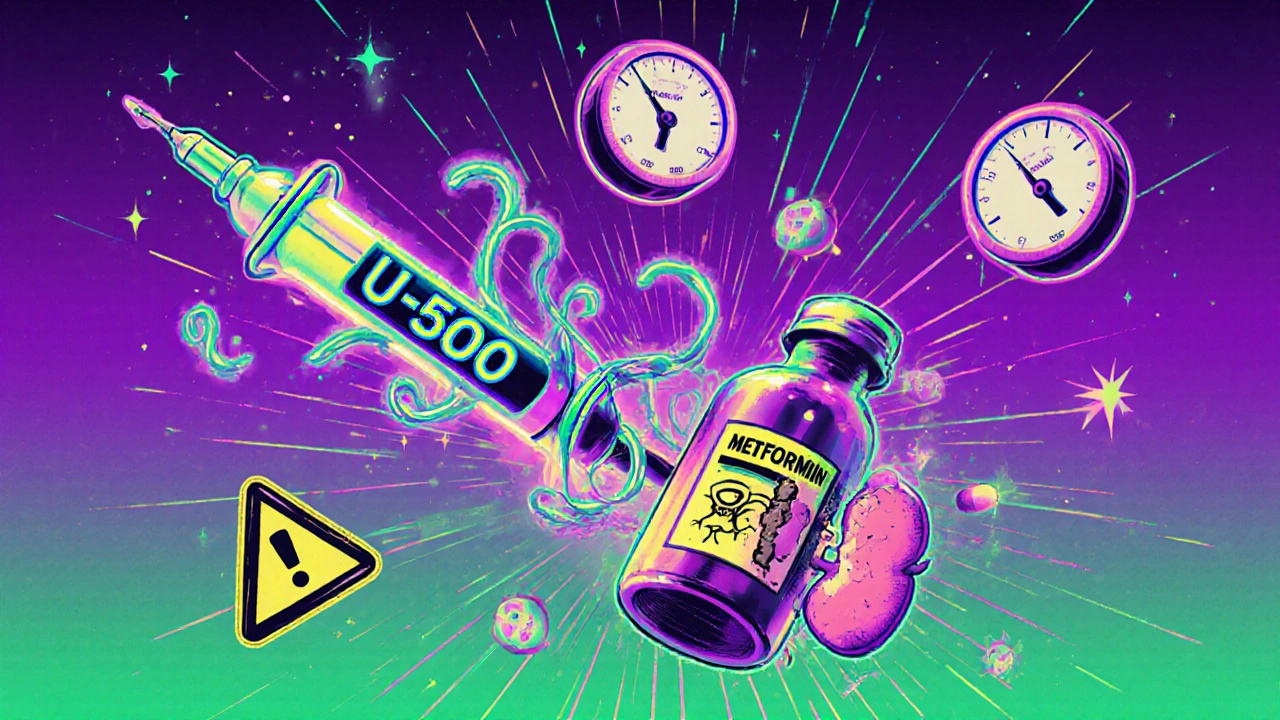Managing diabetes isn’t just about checking blood sugar-it’s about staying safe while doing it. Millions of people in the U.S. take insulin or oral medications every day to control their blood glucose. But these drugs aren’t harmless. Some can drop your blood sugar too low. Others can cause infections, kidney issues, or even diabetic ketoacidosis-even when your sugar levels don’t look dangerously high. Knowing the real risks, not just the benefits, can keep you out of the ER.
What’s Really Going On With Your Medications?
There are two main types of diabetes drugs: insulin and oral (or injectable) agents. Insulin replaces what your body can’t make, mostly used in type 1 diabetes but also in advanced type 2. Oral agents help your body use insulin better, make more of it, or stop your liver from dumping out too much sugar. There are over ten classes of these oral drugs, each with different risks.Metformin is still the first choice for most people with type 2 diabetes. It’s cheap, effective, and doesn’t cause low blood sugar by itself. But it’s not safe for everyone. If your kidneys aren’t working well-eGFR below 30-you shouldn’t take it. Between 30 and 45, you need a lower dose. Above 45, you’re usually fine, but your doctor should check your kidney function every year. Skipping this check can lead to lactic acidosis, a rare but life-threatening buildup of acid in your blood.
Sulfonylureas like glipizide, glyburide, and glimepiride work by forcing your pancreas to pump out more insulin. They’re cheap and effective, but they’re also the biggest cause of dangerous low blood sugar among oral drugs. Up to 40% of people on these meds have at least one low blood sugar episode a year. One in ten of those episodes is severe enough to require someone else to help-like giving you glucagon or calling 911. Older adults are especially at risk. Studies show that 30% of people on sulfonylureas have silent nighttime lows-no shaking, no sweating, no warning. Just sudden confusion or passing out.
Insulin: Powerful, But Easy to Mess Up
Insulin saves lives, but it’s also the most common cause of emergency visits for low blood sugar. There are five main types: rapid-acting, short-acting, intermediate, long-acting, and concentrated. Each has a different start time and duration. Mixing them up can be deadly.Take Humulin R U-500. It’s five times stronger than regular insulin. If you think you’re giving a normal dose but accidentally use U-500 instead, you could overdose by 400%. People have ended up in comas because they confused the pens. Always double-check the label. Never assume. Keep your insulin pens labeled with tape or stickers if you use more than one type.
Injection technique matters too. Injecting into muscle instead of fat can make insulin absorb too fast, causing sudden lows. Rotate your injection sites-belly, thighs, arms, buttocks-to avoid lumps under the skin called lipohypertrophy. These lumps don’t absorb insulin well, leading to unpredictable highs and lows. Use a new needle every time. Reusing needles increases infection risk and can blunt the tip, making shots more painful and less accurate.
Automated insulin delivery systems (AID), like hybrid closed-loop pumps, are changing the game. They adjust insulin automatically based on real-time glucose readings. In clinical trials, people using these systems spent 20% more time in their target blood sugar range and had 40% fewer low blood sugar events compared to traditional pump therapy. If you’re on multiple daily injections and still having trouble, ask your doctor about switching to an AID system.
Newer Drugs, New Risks
The last decade brought powerful new drugs: SGLT2 inhibitors (like empagliflozin, dapagliflozin) and GLP-1 receptor agonists (like semaglutide, tirzepatide). They’re great for heart and kidney protection, but they come with unexpected dangers.SGLT2 inhibitors can cause diabetic ketoacidosis (DKA) even when your blood sugar is only slightly elevated-sometimes under 250 mg/dL. This is called euglycemic DKA. It’s rare, but it’s deadly if missed. The FDA warns that you should stop these drugs at least 24 hours before surgery, during serious illness, or if you’re fasting. Avoid very low-carb or keto diets while on these meds-they increase DKA risk. If you feel nauseous, have abdominal pain, or breathe deeply and fast, get checked immediately. Don’t wait for your sugar to spike.
Up to 5% of people on SGLT2 inhibitors get genital yeast infections. Women get vaginal yeast infections. Men get balanitis. It’s not a sign of poor hygiene-it’s because these drugs make your urine sugar-rich, creating a perfect environment for yeast. Keep the area dry, wear cotton underwear, and talk to your doctor if it keeps happening. You might need to switch meds.
GLP-1 agonists like Ozempic and Mounjaro cause nausea, vomiting, and diarrhea in up to half of users-especially when starting or increasing the dose. These side effects usually fade after a few weeks, but they can be severe enough to make people quit. Start low. Go slow. Don’t rush the dose increases. If you can’t keep food down for more than a day, call your doctor. Dehydration and electrolyte imbalances can be dangerous, especially if you’re also on diuretics or have kidney issues.

Drug Interactions You Can’t Ignore
Many common medications can mess with your diabetes drugs. You might not realize it until you’re in trouble.Antibiotics like sulfamethoxazole/trimethoprim (Bactrim) can make insulin and sulfonylureas work too hard, causing dangerous lows. One Reddit user reported passing out after starting Bactrim for a UTI while on glimepiride. His sugar dropped to 38 mg/dL. He survived, but barely.
Quinine (used for leg cramps), sunitinib (a cancer drug), and somatostatin analogues (like octreotide) can also increase hypoglycemia risk. Even some over-the-counter supplements like chromium or alpha-lipoic acid can lower blood sugar. Always tell your pharmacist and doctor every pill, patch, or herb you take-even if you think it’s harmless.
Alcohol is another hidden danger. Drinking, especially on an empty stomach or with insulin or sulfonylureas, can cause delayed hypoglycemia-up to 12 hours later. If you drink, eat food with it. Never drink alcohol to treat a low. It masks the symptoms and delays recovery.
Who’s Most at Risk?
Not everyone has the same risks. Some groups need extra caution.Older adults (65+) are three times more likely to be hospitalized for low blood sugar than younger people. Their bodies don’t release glucagon as well. They may not feel the warning signs. They’re also more likely to take other meds that interact. Doctors should start them on lower doses and avoid drugs like glyburide, which lasts too long in older bodies. Glipizide is safer because it’s cleared by the liver, not the kidneys.
People with kidney disease need special attention. Metformin, SGLT2 inhibitors, and many sulfonylureas are cleared by the kidneys. If your eGFR drops below 45, you need dose changes or alternatives. Don’t wait for symptoms. Get your kidney function checked at least once a year. If you’re on dialysis, SGLT2 inhibitors are off-limits. Metformin is usually stopped too.
People with heart failure should avoid thiazolidinediones (like pioglitazone) because they can cause fluid retention and worsen heart problems. GLP-1 agonists and SGLT2 inhibitors, on the other hand, are actually recommended for heart failure patients-they reduce hospitalizations and improve survival.

How to Stay Safe Every Day
Safety isn’t just about the drug-it’s about your daily habits.- Keep a written log: Write down your meds, doses, times, and any side effects. Use a notebook or phone app. This helps your doctor spot patterns.
- Always carry fast-acting sugar: Glucose tablets, juice boxes, or hard candies. Don’t rely on snacks-your sugar can drop too fast.
- Wear a medical ID: A bracelet or necklace that says “Diabetic on Insulin” or “On Sulfonylurea.” In an emergency, it saves minutes.
- Know your target range: Ask your doctor what your ideal blood sugar numbers are. Don’t chase perfection. Aiming for too low increases hypoglycemia risk without added benefit.
- Test more when you’re sick: Illness, stress, or infection can make your sugar go wild. Check every 2-4 hours. Adjust insulin if needed, but don’t skip it.
- Get trained on your insulin pen or pump: Watch a video from your pharmacy or ask a certified diabetes educator. Don’t guess.
Collaborative Drug Therapy Management (CDTM) programs-where pharmacists work directly with your doctor-are proven to cut medication errors by 30%. Ask if your clinic offers one.
What’s Changing in 2025?
The landscape is shifting. More people are using dual GLP-1/GIP agonists like tirzepatide (Mounjaro), which is now approved for type 2 diabetes and obesity. Newer insulin formulations are coming with longer, smoother action and fewer peaks. AID systems are becoming more affordable and accessible through insurance.The FDA is tightening warnings. In 2024, they updated labeling for SGLT2 inhibitors to stress euglycemic DKA risk even more. The CDC now tracks medication-related hospitalizations in older adults with diabetes-and 25% of them involve a diabetes drug error.
Future tools will include AI-powered apps that predict your low blood sugar based on your habits, meals, and activity. But for now, the best protection is knowledge, communication, and vigilance.
Can I take metformin if I have kidney disease?
Metformin is not safe if your eGFR is below 30. Between 30 and 45, use it with caution and reduce your dose. Above 45, it’s usually okay, but your doctor should check your kidney function at least once a year. Never start metformin without an eGFR test.
What should I do if I think I’m having low blood sugar?
Check your blood sugar immediately. If it’s below 70 mg/dL, consume 15 grams of fast-acting sugar-like 4 glucose tablets, ½ cup of juice, or 1 tablespoon of honey. Wait 15 minutes, then check again. If it’s still low, repeat. Once it’s back up, eat a snack with protein and carbs if your next meal isn’t coming soon. If you’re confused, passing out, or can’t swallow, someone needs to give you glucagon or call 911.
Are SGLT2 inhibitors safe for older adults?
SGLT2 inhibitors can be used in older adults, but with extra care. They increase the risk of dehydration and low blood pressure, which can lead to falls. They also raise the risk of euglycemic DKA, especially during illness or surgery. If you’re over 65, your doctor should check your kidney function, fluid intake, and mobility before starting. Don’t skip meals or restrict fluids while on these drugs.
Why does insulin cause weight gain?
Insulin helps your body store glucose as fat when there’s too much in your blood. It also stops your body from burning fat for energy. When you start insulin, your body stops losing sugar in urine and starts holding onto calories. This leads to weight gain-especially if you overeat to avoid low blood sugar. GLP-1 agonists and SGLT2 inhibitors often cause weight loss, which is why many doctors now pair them with insulin to balance it out.
What’s the safest diabetes medication for someone with heart failure?
GLP-1 receptor agonists (like semaglutide) and SGLT2 inhibitors (like empagliflozin) are the safest and most effective for people with heart failure. They reduce hospitalizations and lower the risk of death. Thiazolidinediones like pioglitazone should be avoided-they can cause fluid retention and make heart failure worse.
Can I drink alcohol while on diabetes meds?
You can, but it’s risky. Alcohol can cause delayed low blood sugar, especially with insulin or sulfonylureas. Never drink on an empty stomach. Always eat food with alcohol. Don’t drink to treat a low-alcohol blocks your liver from releasing glucose. Limit yourself to one drink per day, and always check your blood sugar before bed if you’ve had any.
If you’re on diabetes medication, your safety depends on more than just your prescription. It depends on how you use it, what else you’re taking, and whether you know the warning signs. Talk to your doctor. Ask questions. Keep a log. And never ignore a weird symptom-especially if your sugar doesn’t explain it.

Girish Pai
November 19, 2025 AT 02:45Let’s cut through the noise-metformin is the only real first-line agent, and anyone who says otherwise is either selling something or hasn’t read the ADA guidelines. The eGFR thresholds aren’t suggestions, they’re redlines. If your kidney function dips below 45, you’re playing Russian roulette with lactic acidosis. And don’t get me started on sulfonylureas-those are basically prescription hypoglycemia bombs for the elderly. Glipizide’s half-life is half of glyburide’s, so if you’re over 65, you’re either smart or dead. No in-between.
Hal Nicholas
November 20, 2025 AT 10:01So let me get this straight-you’re telling me I can’t drink alcohol after dinner if I’m on insulin? That’s literally the only thing keeping me sane. Now I’m supposed to give up my whiskey and my peace of mind? I’m not a lab rat. I’m a person who just wants to enjoy a meal without feeling like I’m being monitored by the FDA.
Louie Amour
November 21, 2025 AT 09:05Look, if you’re using Humulin R U-500 and can’t tell the difference between U-100 and U-500, you shouldn’t be allowed to live alone, let alone manage your own insulin. This isn’t rocket science-it’s reading labels. And if you’re confusing injection sites and getting lipohypertrophy, you’re not ‘diabetic,’ you’re negligent. The fact that people still reuse needles in 2025 is a public health scandal. Get a damn needle dispenser. Or don’t. But don’t blame the drug when you’re the problem.
Kristina Williams
November 23, 2025 AT 08:09Did you know the FDA is hiding the truth about SGLT2 inhibitors? They’re linked to a secret cancer cluster in the Midwest. I read it on a forum. Also, your insulin pen is probably bugged by Big Pharma to track your blood sugar and sell ads to weight loss clinics. They’re using your data to push Ozempic. You think that’s a coincidence? Think again.
Shilpi Tiwari
November 24, 2025 AT 02:16Interesting breakdown on euglycemic DKA-especially the point about low-carb diets amplifying risk. I’ve seen this twice in my endocrine clinic in Mumbai. Patients on dapagliflozin go keto for ‘wellness,’ then show up with Kussmaul breathing and a pH of 7.1. The irony? They were trying to ‘reverse’ diabetes. Meanwhile, their urine is a yeast buffet. Always check ketones if you’re symptomatic-even if your BG is 200. That’s not ‘mild’-that’s a metabolic emergency waiting to happen.
Christine Eslinger
November 24, 2025 AT 18:27Thank you for writing this. I’ve been on metformin for 12 years and just had my first eGFR check last month-it was 48. I didn’t know I needed to cut my dose. I thought if I felt fine, I was fine. Turns out, I was just lucky. I’m scheduling a pharmacist consult next week. Also, I carry glucose tabs in my purse, my car, and my yoga bag. One time, I passed out at the farmer’s market. No one knew what was wrong. I wear my medical ID now. It saved me. You’re not being dramatic-you’re being smart.
Denny Sucipto
November 24, 2025 AT 21:33Man, I just started on semaglutide and holy hell, the nausea hit me like a freight train. Thought I was gonna die. But I stuck with it-slow dose increase, ate crackers, drank ginger tea, and now I’m 6 weeks in and I feel like a new person. No more 3 p.m. crashes. Lost 22 lbs. My wife says I’m not yelling at the TV as much. It’s not magic, but it’s real. If you’re scared of the side effects? Start low. Go slow. Your body’s not your enemy. It’s just trying to catch up.
Holly Powell
November 24, 2025 AT 22:13It’s fascinating how the article casually mentions ‘AID systems’ as if they’re universally accessible. Let’s be real-most people on Medicare can’t afford them. And the FDA’s ‘tightened warnings’? That’s PR spin. The real issue is that insurers still won’t cover continuous glucose monitors unless you’re on insulin and have 3+ hypoglycemic events per month. This isn’t safety-it’s a privilege system disguised as medical advice. The real danger isn’t the drug-it’s the system that makes you choose between food and your pump.
Emanuel Jalba
November 25, 2025 AT 07:05⚠️⚠️⚠️ GUYS. I JUST FOUND OUT MY INSULIN PEN WAS RECALLED IN 2023 AND NO ONE TOLD ME. I’VE BEEN USING IT FOR 8 MONTHS. 😱 MY KIDNEY DR. IS A CORRUPT PHARMA SLAVE. 🚨 I’M GOING TO THE PRESS. #DiabetesCoverUp #SaveOurLives 🚑💉
Heidi R
November 26, 2025 AT 21:56Metformin causes B12 deficiency. You’re not just risking lactic acidosis-you’re risking permanent nerve damage. And you didn’t even mention that.
Christine Eslinger
November 28, 2025 AT 09:05Good catch. B12 deficiency is real-up to 30% of long-term metformin users are deficient. That’s why I get mine checked yearly. If you’re numb in your feet or feel constantly tired, ask for a serum B12. It’s a simple blood test. Fixing it takes a $10 supplement and saves you from years of neuropathy. Knowledge isn’t just power-it’s feeling your toes again.